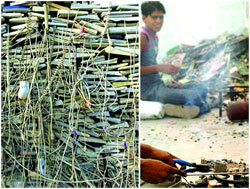Pour electronic waste into poor countries
New America Media (October 17, 2008) said the US Environmental Protection Agency (EPA) did not seem to do anything about the US situation of e-waste dumping into third world countries. , including China, Nigeria and India.
The report of the US General Audit Office (GAO) said that the United States annually sends more than 150,000 tons of e-waste to India, making New Delhi the world's largest e-waste dump (Hindustan Times newspaper).

Each year the United States sends more than 150,000 tons of e-waste to India.Only in New Delhi, there are about 25,000 workers specializing in dealing with e-waste with 10,000-20,000 tons of electronic waste each year
BusinessWeek (October 15, 2008) denounced: the e-dumping of e-waste into poor countries is now becoming an ' industrial ' silverware in the West, especially the US .
Supreme Asset Management & Recovery, an electronic waste treatment company in Lakewood (New Jersey, USA), is eating out. This is one of America's largest electronic bottles. Every day, many 'dumped' trucks of computers, monitors, printers, televisions . are found - all kinds of toxic things containing lead, mercury and cadmium, substances that have Can cause nerve damage as well as cancer. The e-waste processing industry is a silver industry in the US, with about 1,200 small companies competing for a piece of cake with sales of more than $ 3 billion in 2007.
GAO's report in mid-September 2008 made Supreme face as one of 43 US companies specializing in selling e-waste to Asia. However, if done properly, e-waste disposal is not profitable compared to selling straight lots of untreated e-waste for importers in poor countries. In Hong Kong, Asia's e-waste import center, a container of computer and television screens not yet sold for $ 5,000 can bring a net profit of $ 4,000! Supreme lived a lucrative life this way.
Richard Wray in an investigative report published in The Guardian reports that thousands of scrap computers from Western Europe and the US have visited West African ports every day.' Millions of tons of e-waste are disappearing from developed countries every year to appear in developing countries, despite international prohibitions ' - according to Luke Upchurch of Consumers International, which represents more than 220 consumer group in 115 countries. According to Greenpeace, of 8.7 million tons of e-waste discharged annually in the EU, up to 6.6 million tons are not recycled according to the process. In addition, every year the world throws out 20-50 million tons of toxic e-waste .

In March 2007, the United Nations launched a global initiative (Solving the E-Waste Problem - StEP) to solve the e-waste problem (with the participation of a number of multinational companies, including There are Microsoft, Ericsson, Hewlett-Packard and Dell). Not only calling on producers to pay more attention to the recovery policy - recycling of old generation equipment (recently Sony and LG Electronics cooperated with Waste Management Recycle America - the largest civil waste recycling company The United States - in allowing consumers to exchange old products for new products, StEP calls on people in poor countries to limit their livelihoods by e-waste.
- New technology prevents old devices from becoming toxic
- Technology waste causes death in poor countries
- The world emits over 40 million tons of electronic waste in 2014
- The United Nations warns of the harmful effects of e-waste
- 'Graveyard' Western electronic waste in Africa
- Electric waste like global time bomb
- Did you know: recycling electronic waste can benefit more than ... gold digging
- Phone is water soluble
- Sweden recycles 99% of its waste
- Extremely fast gold emulsion from electronic waste
- Abbott reduced the price of drugs for AIDS in poor countries
- New technology turns waste plastic powder of electronic circuit boards into building bricks
 Is the magnetic North Pole shift dangerous to humanity?
Is the magnetic North Pole shift dangerous to humanity? Washington legalizes the recycling of human bodies into fertilizer
Washington legalizes the recycling of human bodies into fertilizer Lightning stone - the mysterious guest
Lightning stone - the mysterious guest Stunned by the mysterious sunset, strange appearance
Stunned by the mysterious sunset, strange appearance